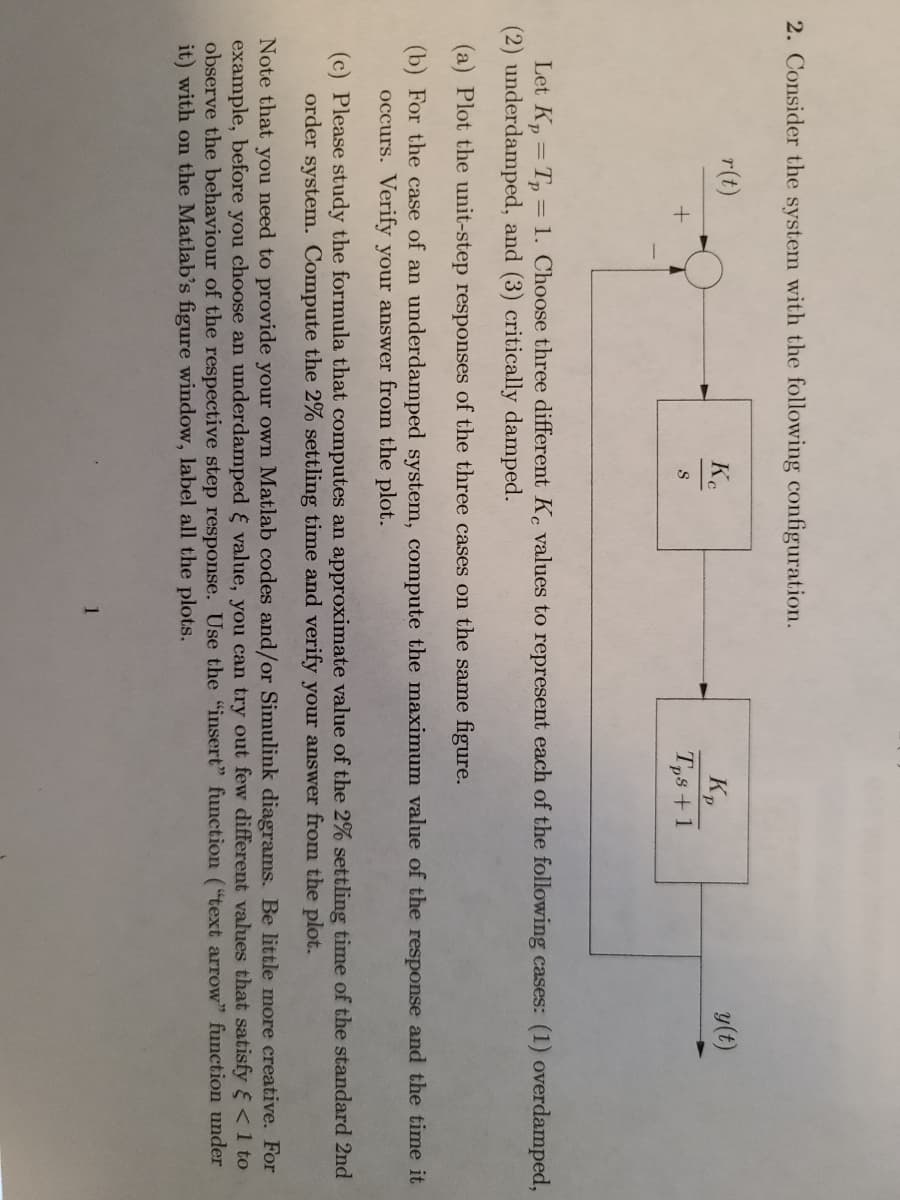2. Consider the system with the following configuration. r(t) Ke y(t) Kp Tp8 +1 Let Kp = T, = 1. Choose three different K. values to represent each of the following cases: (1) overdamped, (2) underdamped, and (3) critically damped.
2. Consider the system with the following configuration. r(t) Ke y(t) Kp Tp8 +1 Let Kp = T, = 1. Choose three different K. values to represent each of the following cases: (1) overdamped, (2) underdamped, and (3) critically damped.
Introductory Circuit Analysis (13th Edition)
13th Edition
ISBN:9780133923605
Author:Robert L. Boylestad
Publisher:Robert L. Boylestad
Chapter1: Introduction
Section: Chapter Questions
Problem 1P: Visit your local library (at school or home) and describe the extent to which it provides literature...
Related questions
Question

Transcribed Image Text:2. Consider the system with the following configuration.
r(t)
Ke
y(t)
Kp
Tps +1
S
Let K, = T, = 1. Choose three different K, values to represent each of the following cases: (1) overdamped,
(2) underdamped, and (3) critically damped.
(a) Plot the unit-step responses of the three cases on the same figure.
(b) For the case of an underdamped system, compute the maximum value of the response and the time it
occurs. Verify your answer from the plot.
(c) Please study the formula that computes an approximate value of the 2% settling time of the standard 2nd
order system. Compute the 2% settling time and verify your answer from the plot.
Note that you need to provide your own Matlab codes and/or Simulink diagrams. Be little more creative. For
example, before you choose an underdamped & value, you can try out few different values that satisfy <1 to
observe the behaviour of the respective step response. Use the "insert" function ("text arrow" function under
it) with on the Matlab's figure window, label all the plots.
1
Expert Solution
This question has been solved!
Explore an expertly crafted, step-by-step solution for a thorough understanding of key concepts.
Step by step
Solved in 2 steps with 2 images

Knowledge Booster
Learn more about
Need a deep-dive on the concept behind this application? Look no further. Learn more about this topic, electrical-engineering and related others by exploring similar questions and additional content below.Recommended textbooks for you

Introductory Circuit Analysis (13th Edition)
Electrical Engineering
ISBN:
9780133923605
Author:
Robert L. Boylestad
Publisher:
PEARSON

Delmar's Standard Textbook Of Electricity
Electrical Engineering
ISBN:
9781337900348
Author:
Stephen L. Herman
Publisher:
Cengage Learning

Programmable Logic Controllers
Electrical Engineering
ISBN:
9780073373843
Author:
Frank D. Petruzella
Publisher:
McGraw-Hill Education

Introductory Circuit Analysis (13th Edition)
Electrical Engineering
ISBN:
9780133923605
Author:
Robert L. Boylestad
Publisher:
PEARSON

Delmar's Standard Textbook Of Electricity
Electrical Engineering
ISBN:
9781337900348
Author:
Stephen L. Herman
Publisher:
Cengage Learning

Programmable Logic Controllers
Electrical Engineering
ISBN:
9780073373843
Author:
Frank D. Petruzella
Publisher:
McGraw-Hill Education

Fundamentals of Electric Circuits
Electrical Engineering
ISBN:
9780078028229
Author:
Charles K Alexander, Matthew Sadiku
Publisher:
McGraw-Hill Education

Electric Circuits. (11th Edition)
Electrical Engineering
ISBN:
9780134746968
Author:
James W. Nilsson, Susan Riedel
Publisher:
PEARSON

Engineering Electromagnetics
Electrical Engineering
ISBN:
9780078028151
Author:
Hayt, William H. (william Hart), Jr, BUCK, John A.
Publisher:
Mcgraw-hill Education,